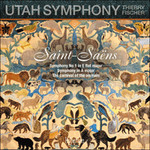|
Back
01/17/2020
“Works by Camille Saint-Saëns – Volume 3”
Camille Saint-Saëns: Symphony n° 1 in E-Flat major, opus 2 [1] – The Carnival of the Animals, R. 125 [2] – Symphony in A major, R. 159 [3]
Madeline Adkins (concertmaster), Utah Symphony, Thierry Fischer (music director)
Live recording: Abravanel Hall, Salt Lake City, Utah (December 8-9, 2017 [2], February 23-24, 2018 [1], March 2-3, 2018 [3]) – 82’05
Hyperion CDA68223 (Distributed by PIAS) – Booklet in English, French and German

   
Thierry Fischer and the Utah Symphony have now reached a milestone by being the first American entity to record all of Camille Saint-Saëns’ symphonies. Fittingly bookended in the key of A, this compendium was launched on September 22, 2017 with the Symphony n° 2 in A minor and an eventual wind down on March 3, 2018 featuring the Symphony in A major [as reviewed here]. Amongst the three volumes (including the middle issue housing the venerable ‘Organ’ Symphony), Thierry Fischer has interspersed a sampling of orphic and recognizable œuvres. One can give a nod of approval to this approach since these outlier ‘breathers’ are ‘spacers’ which actually separate and strengthen the importance and dynamics of each symphony. This final release ‘tips the scale’ to lighter fare, and it re-emphasizes Saint-Saëns’ delicate Classicism/Romanticism fulcrum.
Evident in the opening Symphony n° 1 in E-Flat major is a forward scale of instrumental immensity (as opposed to the Symphony in A major) that points to Gounod’s assistance in color enrichment. Maestro Fischer approaches the “Adagio – Allegro” with punctilious consideration. Woodwinds gain the upper hand in elegance as they usher in the ensuing “Scherzo”...the treatment expounds the air with dove-like softness and respectful cadences: demure though never too far away from the symphony’s war-like overtones…this passage is brilliantly crafted. Thierry Fischer seems to dispel any anxiety or tumult by rendering the penultimate “Adagio” as a humble, elegant poetic reading...notes effortlessly find their own lofty way to fly, particularly with the accentuation of harp and ensuing string lines. If French lyrical touches seem to surface ever so greatly, it would be handed over to this movement which reaffirms the composer’s future sights of gracious elegance. We’re never far away from cries of martial battalion when seguing into the climactic “Finale”. [For opera aficionados, one can’t help but mirror this virtuous oration upon the forthcoming 1901 tragédie lyrique, Les Barbares and its intermingling harp glissandos.] Enthralling. Unrelenting patience encapsulates M. Fischer’s designs...the template keeps returning and returning without hiccupping, and it’s also the power behind the fugue inertia and its methodical layering.
Spotlighted by a voluminous roster, Camille Saint-Saëns’ merveille zoologique is a gift for all ages. The assemblage of characters and objects boldly jump from instrument to instrument in an organically original mélange of musical charm. Though too numerous to credit, Utah Symphony’s artists are poised to distinguish each tableau with sizable humor, including pecking, braying, running, roaring, hopping, cuckooing, shimmering and plodding. But the biggest attention-getter would handily defer to “Le Cygne”. In all its elegance and suave delectability, Pegsoon Whang’s cello floats atop the water with imposing pianistic sprinkles by Jason Hardink and Kimi Kawashima. There’s no loss of words to describe how the piece weighs in on the listener, for it’s a purely magical moment.
Moreover, turning back the clock is the best way to close out this CD. The Symphony in A major glances back to a congealed framework of Bizet’s Symphony in C major, alongside Mozartian trimmings and Mendelssohnian flair. Camille Saint-Saëns was approximately 15 years of age (completed c. 1850) when he composed this refreshingly innocent, though technically proficient composition. The “Poco adagio – allegro vivace” is riddled with flute flourishes that gives ‘icing to the cake’ with its straightforward sense of simplicity and youthful elegance; furthermore, the passage skirts on the lightest of tightropes. But it’s the “Larghetto” that has the densest time component, giving Thierry Fischer plenty of room to nudge at the pontifical cornerstone being poured inside Camille Saint-Saëns’ cerebrum. Clarinet overlays in the ensuing minutes are bounteous, and they give the movement flavored response. Skeletal Beethovenian scripts also generate crystalline string dialogues that are lightly peppered by oboe and flute during the whimsical “Scherzo”. Marked by ’leggiero, staccato’, M. Fischer lifts his awareness with frothy acuity during the “Finale”...it pulsates rays of Berlioz’s “Queen Mab”, though Saint-Saëns’ passage is gently milder by way of capricious endeavors. Difficult to maintain a consistent metronomic capacity, Utah Symphony, however, forges through unabashedly and with pinpoint accuracy...an aural delight.
Most importantly, Thierry Fischer eyes the horizon with steadiness and reasons through every fold of expression. Perhaps saving the best for last, “Volume 3” has pure persuasion and pure genius. We ‘tip our hats’ to Thierry Fischer’s Anglophone coliseum for presenting Camille Saint-Saëns with stateside distinction and thoughtful sophistication.
Christie Grimstad
|